The bus ride to Cape Coast was fairly comfortable. We began with watching a Nigerian movie on the bus TV, but the discs were scratched, so they scrapped that. For the rest of the trip, as the sun began to set, we drifted in and out of sleep (I did so to the sound of Goldenchild’s “Imagine Me” Gospel Mixtape...holler). The trip took about four hours; we had left the station at about 5pm and arrived at around 9PM. The roads were pretty good, except for one stretch that was paved for 100 metres than dirt for 100 metres, and so on...I don’t get that...c’est la vie!
When we got to Cape Coast, we met a taxi driver named Bright at the bus station. At that point, we were not sure of our accommodation. We requested to go and see the Savoy Guest House which was in the town. When we got there, we both weren’t feeling it. Bright suggested the Arafynn Guest House, so we went to see it. I liked it, but Pierrette wasn’t sure about it as she did the towel check (and the towel in the bathroom did look kind of suspect), so we headed to a place she had researched called the Hansboro Botel. You should have seen my face when they told me that the little lake on the grounds had crocodiles in it...for real, crocodiles...you walk to your room beside the water, and there are crocodiles...when I saw Pierrette’s pictures of her safari journey in Kenya I could understand why this didn’t surprise her (she saw some big crocodiles! And lions! Lions eating antelopes! And Zebras, a cheetah, wildebeast, giraffes, elephants and a cheetah!!!).

Above: Breakfast over the lake.

Above: Breakfast in the lake...
The first room we were brought to had lights that didn’t work, but the second room was fine. After getting settled, we had a good rest, looking forward to our day of sight-seeing. Oh, I have to mention that the shower experience was frightening for me, as I tried to move the shower head a shock went through my hand. I then saw the faded out sign that said not to touch it for danger of being shocked...the next morning, I felt a similar feeling of a shock on the bottom of my foot when I realized that I was bitten by a small spider. While it hurt, it was not serious...nonetheless, an adventure.
Anyhow, breakfast on the water was very nice, and I saw one of the crocodiles swimming...again, Pierrette was no where near as excited. That morning, we packed our things and headed to town. Our stops included the bus to get our tickets back (me to Tamale, Pierrette to Accra), to the Arafynn where we would spend the next two nights (the Hansboro wasn’t all that it was made out to be), and then to the Cape Coast Castle.
When we got into town, we first stepped into the Tourist Building, but it was being renovated and is apparently not supposed to be open on Saturdays. Connected to the building was a church courtyard where a large entourage wearing matching outfits headed for what appeared to be a funeral. That was on our way to the castle, yet, later in the day, when we had left the castle, we came out to meet a large wedding in a church a few doors away from the funeral...makes you say ‘hmmmm...’

Above: What appeared to be a funeral procession.
Heading into the castle I had to slow down to pray. I was actually praying a lot on the way down from Tamale and heading to Kumasi and to Cape Coast. I could feel that something powerful, very powerful was going to happen over the weekend. I sought God that we would be prepared to see all we should see and to receive all that we were to receive.
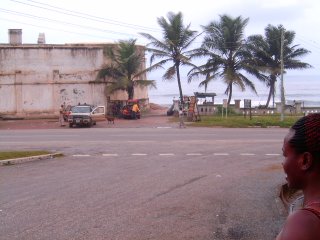
Above: Street view of Cape Coast Castle.
When I was in Dakar, Senegal in 2001, I was attending the United Nations World Youth Summit. As one of three Canadian representatives, it was an incredible experience to be among so many of the globe’s driven and inspired young people. Part of what we experienced was a journey to Goree Island, known as “the point of no return”. It was a powerful moment in my life; poetically haunting in the simultaneous presence of horror and survival, strength and suffering, unrecoverable damage and making the most of life. The personal impact ran deep into an experience that occurred later that evening which is something that is beyond typing.
With this experience in mind, I prayerfully trailed Pierrette toward the Cape Coast castle. Upon entering, we were brought to the museum on the grounds to view a 40 minute documentary. It detailed life in West Africa before the evil trade began (I will use that term to describe what is referred to as the Trans-Atlantic Slave Trade, as our young guide continually titled that moment of history). The film looked at how it started, the impact that it had, and focused on the remaining linkages and legacies that connect the African Diaspora.
Let me explain the term diaspora. From what I have been taught, the term diaspora has Latin or Greek roots and means “scattering”. First used to describe the ‘scattering’ of Jewish people throughout the globe, it is a term that embodies being spread out and separated, while remaining connected. Spread out amongst geographical expanses, and connected through history, culture, language, religion, spirit, and so on. The African Diaspora is said to be the largest forced Diaspora in the world. The connections go from Africa throughout Latin America, the Caribbean, North America, and Europe, and extends into the far reaches of the globe including Australia, the Czech Republic among many other countries.
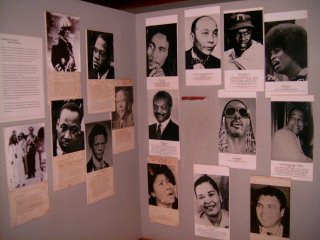
Above: Photos of Robert Nesta Marley, Elijah Muhammed, Jackie Robinson, Angela Davis, Jesse Jackson, Stevie Wonder, Rosa Parks, Muhammad Ali, Marcus Garvey, Malcom X, Dr. King, W.E.B DuBois, Emperor Haile Selaissie, and three others I am not sure of.

Above: Pre-Emancipation Heroes Toussaint L'Overture, Harriet Tubman and Frederick Douglass.
I was glad to watch the film as it set a number of things in my mind. It actually provided the basis for a poem that I will write and publish when it is complete. Among the things that stood out were these: the technology of extracting, heating and shaping gold among many other technologies which testify to genius...genius. There was a clip of Malcom X speaking where he asserted the absolute and inherent right as men and women that people of African descent have everywhere...it is stunning to think that this world has been a place, and continues to be, in need of such an assertion. There was also a link made between songs and games in West African culture that were of the same traditions seen in Hip Hop...back and forth between the little children in a Ghanian classroom room and Chuck D of Public Enemy on stage.
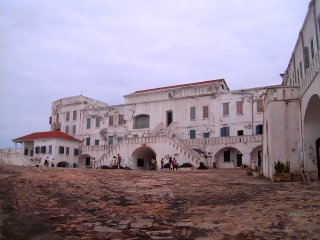
Above: The main court on the grounds.
Soon after the film, we began our tour. We crossed the courtyard of this large castle and headed toward the doorway with the title “Male Slave Dungeons”.
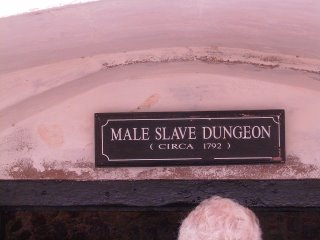
As our guide began speaking, he explained how the techniques employed by European forces to establish and maintain the practice operated. The use of alcohol, deception, stirring up conflict and providing both sides with weapons, and generating instability to devalue to worth of local resources were listed. These strategies echoed the identical devices used to this day throughout South Africa, Zimbabwe, Rwanda, Sierra Leonne, Nigeria, Sudan, and throughout the continent. Not only on the African continent, but worldwide; not only from the 1500’s to the 1800’s, but to this very present moment. As he spoke, the words that stirred in my heart, were that, “nothing has changed”. While the evil trade has come to a cease, while nations have become independent, while nothing should ever be spoken to belittle what was endured, nor to belittle what was achieved through resistance and sacrifice – for the achievements have been great – when you look at what is going on, one can see the same spirit. The wealth of the most resource rich continent on the planet (and if the foundation of money is resources, Africa should be the wealthiest region of the earth) continues to benefit other nations, few domestic interests, and are under the whims of foreign private interests (much of whose influence, power, and wealth come from crimes of conquest and systems established via the colonizing process). Whether or not there exists a cure for AIDS, there are drugs that can prolong life greatly and ease suffering. Yet, thousands and thousands are dying of the disease with no support. In an article about a donation made by the Bill and Melinda Gates Foundation expressed that 6 Million people in Africa die of the disease each year...is it not ironic that the number 6 Million has been made famous by the estimated number of those killed in the holocaust of Jewish Europeans during World War II? Ask yourself in Toronto, how many people do you know of that died of AIDS? Ask that question in Swaziland...in Kenya...in South Africa and the response will be drastically different.
So there we stood, at the mouth of this dungeon, as the words are stirring in my heart, “nothing has changed”. Again, that does not discount the sacrifice of ancestors, of victories and progress, it speaks to the unrepentant greed which birthed the evil trade and continues to keep the spirit of it’s exploits alive.

Above: Our tour into the Male Dungeon.
I had to touch the wall and feel the texture of the stone as we descended into the dimly lit hallway, forcing our eyes to adjust to the shadows.
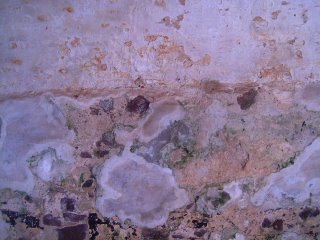
As we walked, the scent also crept into my system. The scent of moisture and decay and of history was strong. In the male dungeon we were made aware that the current spaciousness and cleanliness was not reflective of the conditions. The room was lit by a small slit in the wall which did little more than let you know that there was a sun, somewhere. What we did not have to contend with was being packed shoulder to shoulder in there. We did not have to deal with sweat, blood, tears and the fluids of our bodily functions building up for countless periods of time. We did not have to deal with the death and rot of wounds and those whose bodies gave into to the great burden surrounding us. We did not have to stay there either. As our guide led us into another room where the light was slightly better and where a shrine to the millions of ancestors that had passed through the castles of the region (an estimated 12 million), we had the choice of leaving. As our group moved on, I could not.
I crouched near the ground and leaned on the wall, facing the slit that allowed some reflected light into the room. It just hit me that, THIS REALLY HAPPENED.
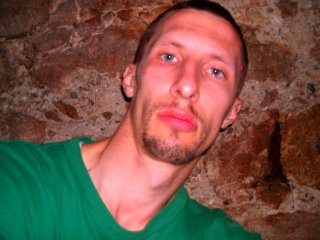
I sat there looking at the light and I asked of God, “What did you do with their prayers?”.
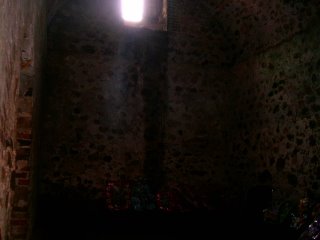
I do not feel doubt of God, but I do not pretend to understand either. I know that they prayed in that room. I asked the question that I believe has an answer – an answer that I do not know – ‘what happened to their prayers?’.
Maybe they were answered in little miracles. Maybe they were addressed in the truth that “every work, be it good, or be it evil, will be brought into judgement” (Eccl. 12). Maybe they were answered in survival.
I remained there listening. In the basement, you can feel the rumble and roar of the waves as a deep vibration more than you can actually hear it. The pattern is accentuated by the vibrations. A wave crashes in, and is dragged back out to sea. Another wave stumbles over the retreating wake and crashes. Over and over. A journey that took months, as that wave traveled from it’s origin, ending on the shore and beginning again as it falls back into the ocean.
I listened to the regularly irregular pattern and wondered how it could just go on, regardless of what was happening. I wondered, ‘Why didn’t the waves stop crashing and the rains stop falling and the sun stop shining until this atrocity stopped?’ It seemed strange that the sea could continue to roar, or did it? Maybe the tempest of the sea rose in anger over injustice. Maybe storms, as Mumia Abu Jamal once wrote from within his death row cell in Pensylvania “Night(s) of Power”, testified of the crimes committed in the structures that the rains fell upon.
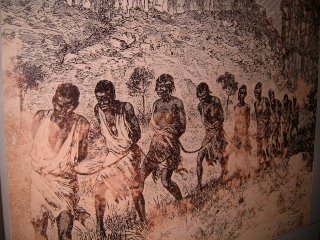
As I sat there, listening to the rumble of the sea that vibrated so deeply in that dungeon, and looked to the faint light asking what happened to the prayers of those who were confined in this place, it hit me again, ‘THIS REALLY HAPPENED’.

Above: Human transport diagram.
I have heard artists describe it in music, I have read books, heard lectures, seen paintings and photographs...much of my university career was focused on related subjects...I have even been to Goree Island, and I have felt the ancestral presence in Buxton, one of the communities established along the Underground Railroad.

I have thought about this for years and years, yet it was a shock to me. It is beyond my comprehension at this point...THIS REALLY HAPPENED.

I sat there and tears fell. I did my best to mute the sound of crying, but the tears continued to flow as those words passed across the eyes of my understanding.
When I re-joined the group being given the tour they were in a room with a shrine, but I did not hear the explanation of the room. From there we proceeded through the courtyard. We passed to graves of individuals that were buried in the courtyard, one of whom was the first African Anglican priest, who taught at a school on the castle compound that was set up for the children born of the rape of captive women.
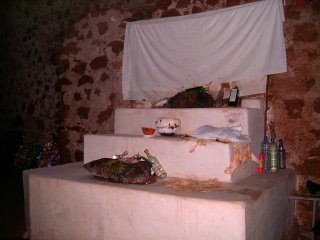
Our steps then went to the other side of the room to the female quarters, where we heard of the additional burden suffered by the women in menstruation, pregnancy, and rape. Again, the quarters were dim and had a strong scent, but it was nowhere near what would have been endured...as powerful as it was, it is only really a faint remnant. Mama Souka commented upon my visit to Cape Coast saying, “you only saw the place, you didn’t even see what really happened there”. It is true, because we know it, we imagine it, we feel it, but to see it...to live through it...or die in it...
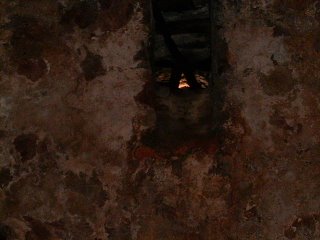
Above: this is the view of the limited light in the Women's Dungeon.
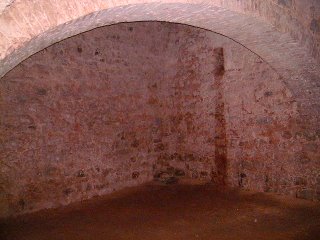
Above: This is a broader shot of the Women's Dungeon, made bright by the camera flash.
Beside the female quarters is “The Door of No Return”.

This is the part of the castle that opens up to the sea. Centuries ago, it was right on the water. At that time, the dungeons would have been saturated and swept by the huge gusts of waves that would crash the walls. As we opened the doors and walked through them, we were met with the sight of dozens of fishing canoes and crowds of people near the Oceanside. We were told that captives would be taken in smaller boats to the large ships that would be waiting in the bay.

Life around us was so vibrant. The spattering of the colours of clothing and the flags that adorned the fishing boats, the brown of the sandy beaches and the green of the hillside both with a scattered covering of buildings (ramshackle to historic), framed by the interchanging of the shades of blue, the slightly brown and the crashing white of the water and the motion of it’s waves flooded our eyes. From a time capsule where treachery and terror is etched for the ages to witness, to everyday life – those fishing, talking and playing soccer on the beach were not sharing in this sombre moment.
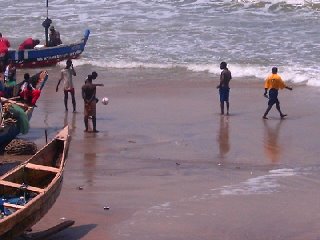
Above: Soccer on the beach as we tour the castle.

Above: The view along the coast from the "Door of No Return" / "Door of Return"

Above: Closer shot of community beside the castle.

Above: Roadside view of community beside the castle (this shot leads toward ocean shots above).
As the eyes of those outside moving about were set upon this group of mixed nationalities, from Ghana to Canada, I could feel so many different thoughts that people were having. Filled by the stream of thoughts, I turned my attention back to the tour.
On the outside of the door, a plaque said “Door of Return”. Not long ago, the remains of a woman from Jamaica and a man from the United States (both the descendents of enslaved Africans) were brought back to the castle across the ocean. They were walked from the sea and through the door, leading to the renaming – the “Door of Return”. The story of the path of those remains continues with them being brought up in the countryside to a place known as “The Last Bath”, but I was to find more about that later on. At this point, we were invited to walk back into the castle.
As I was waiting for the group to re-enter, I wanted a photograph of the door without the people. I ended up taking a picture of Pierrette walking through the door.

Once I entered through the door, I took another picture of her silhouette as she walked up the corridor, into the main court.
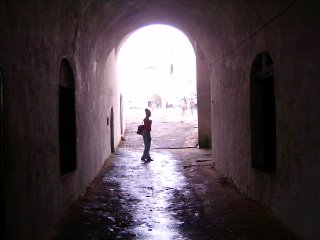
It was a symbolic moment of return. It was also at that moment that a foreshadowing came upon me. I wondered how she felt being there with me. As a woman of African descent, raised in Canada, born as a Jamaican...called Jamaican because of independence and survival and the power and beauty endowed upon that globally recognized nation. I wondered how she felt being there with me. I wondered if it bothered her, or if it was hard for her. It didn’t seem to be a problem, but I wondered. More would come of this later in our journey.
Passing through the court again, we were brought to a room without any window, ventilation or water where those deemed as ‘rebelious’ were brought and left to die. I arrived as the group was being escorted out of the room. As each person exited the room, our guide slapped the top of the door and said something in Twi (I think). I later figured that it was something to ‘ward off the spirits’ – though I am still not sure about that. As they continued on to the next part of the door, I went into the room. The heaviness of the place hit me. Again, I was leaning against the wall contemplating my surroundings when I noticed some loose stones on the ground that had fallen from the wall. This was not common at all in the castle. I thought that I could pick up a stone and keep it. Right away I felt a strong feeling in my heart telling me not to take anything with me from there. Still curious, I approached the small pile of stones. As soon as I bent down and touched the stones, I felt and an electric feeling and the light bulb on the other side of the cell blew out leaving me in the dark. While I was a bit startled, I know that I am walking with God. I got the point and I proceeded out of the cell.

Above: The entrance to the condemned cell.
Upon exiting the cell, Pierrette saw my face and asked, “Chris, are you okay?”. I told her ‘yeah, then I explained what happened’. We went back inside as I described it and she was surprised to see the light now out. She could also feel something strong in there. Again, the knowledge that God is in control and reigns was a source of peace. I also want to add that I did not feel a threat or scared at all, just a presence making itself known.
As we continued the tour, we were brought upstairs. It was not long before our tour was disbanded. From that room, which may have been an office, or may have been the quarters of these criminals of the one the most impactful crimes against humanity, I gazed out of the window at the ocean.

I began to pray there. As I spoke to God, I realized that He has shown me a lot about these things and that there is a reason. I have known this for some time based upon other experiences in Senegal, in Buxton and throughout my life, but I committed myself to God that what ever I must do, and wherever I must go, whatever His will for me is in regards to bringing healing from these horrors, that I would do it and I would go there. He spoke a lot into my heart in that moment and while we lingered around the castle.

I bought a book there by Walter Rodney titled “How Europe Underdeveloped Africa”, and I also saw the book “Things Fall Apart” by Nobel Prize winner, Chinua Achebe. Having read it years ago, the message hit me again. The Roots (a Hip Hop group) actually did an album of the same title. This album had six different album covers, each with a photograph testifying of the warfare that the African Diaspora has survived...one photo is of the charred remains of a church that was bombed...another is of a child with tears running down his face. I skimmed the last few pages in search of a paragraph that hit me like a truck of understanding when I first read it yers ago. (If you don’t want to spoil the novel – though this point won’t really spoil it – then I caution you now). In the book, you read of a Nigerian village named Umofia. The story takes place in the first generation that this town has really had contact with Europeans; however, the story mostly focuses on the failed passing of a legacy from father to son due to character conflicts. At the end of the novel, you have just completed a riveting story of this man and his life and his death. There is a European observer who sees this man’s dead body and remarks that, ‘this story could make a chapter in his book’, then corrects himself saying, ‘more likely a paragraph’...a paragraph to convey what you just read a novel about. It is a powerful statement to remind us that when we look at history, and we see a paragraph here and a paragraph there, know that there is a whole novel worth of reality that was overlooked.
For the next while, I walked around the castle, looking at the ocean, at people on the beach, at the structure and at the sky.


Upon leaving, Pierrette and I searched the town for a place to cash her travelers cheques. On this round about journey we got to see the town, including Black Star Books (which has a book that I must go back and get), before the next, unexpected, doorway in this journey was opened to us.
The next stop would be Elmina.

Above: The structure on the right side of the picture is the Elmina Castle as seen from teh Cape Coast Castle.
1 comment:
Wow. I credit you and your friends for your strength. Just reading your blog and looking at the pictures is more than I can bear. Yes, this really happened. We take so much for granted.
Post a Comment